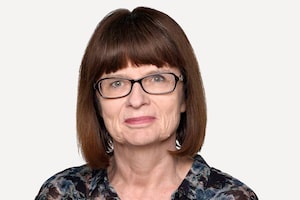It was International Women’s Day this month, and it’s been a year of news about women. So why does the news business struggle to show that women are half the population?
Last year I surveyed this paper for a month and found a daily average of 19 photos of men and seven of women – 27-per-cent female representation. This did not include photos of writers.
This year saw an improvement, with an average 25 photos of men and 13 of women – 34-per-cent female representation – but really nothing to brag about.
That doesn’t include International Women’s Day itself, which had 21 photos of men and 24 of women, thereby demonstrating that with planning of stories about women you can change the mix.
That day included the news of governments, politics and crime, which tends to feature more men than women, but it also included a feature on the surfing sisterhood in Tofino, B.C., an opinion piece on celebrating trans women, a business opinion that hiring more women is good for productivity and wages, a poster-size photo of female soccer players and another full page of photos of women in male-dominated sports.
These features and others, such as a video on women’s sledge hockey and news of Viola Desmond on the $10 bill, were prominent that day on digital platforms.
Photos have impact and show women as world, business and community leaders. But women need mentions in articles, too. So I also surveyed the references to men’s and women’s names.
That was even more lopsided. On International Women’s Day, there were references to 165 men and 75 women. Two weeks later, there were 127 men and 53 women, and on a Saturday 335 men and 120 women. Now, this is skewed by sports coverage, which includes stories referencing many male players on many teams, but even without Sports, the ratio was two to one.
New York Times writers Amanda Taub and Max Fisher wrote an Insider column called “If Only Quoting Women Were Enough,” about studies showing the ratio of three-to-one news coverage of men versus women and their efforts as global affairs columnists to move the needle. They referenced an article on Afghanistan that quoted only women and was praised by readers, but they said efforts to quote more women is “only the final step in a process of gender discrimination that begins long before we pick up a phone.”
I agree with them that while journalists can’t change the balance of men and women in business, politics and academia, they can dig deeper to find a greater diversity of voices, including those of qualified women.
And there’s more to consider. Good reporting gets beyond crime and politics to show community life – like the feature on the first openly transgender player in the Canadian Women’s Hockey League or the double-page spread on the Arctic Winter Games.
Readers notice when Sports, for example, focuses on women. And I also hear criticism about missed opportunities, as from one reader who asked why Canada’s gold medalist at the World Figure Skating Championships, the first Canadian woman to win since 1973, was on page 8 of the Sports section. I agree with the Toronto reader that Kaetlyn Osmond’s victory was clearly more important news.
Others complained about an online headline about a soldier who killed his girlfriend and then himself that initially said: “Former soldier who died with woman was broken from PTSD.” It was rightly changed to: “Former soldier who killed girlfriend in murder-suicide was broken from PTSD.” Headlines at times can be blunt or wrong with little balance or sensitivity to the people involved, especially in crimes, and this one is another reminder to keep the victims front and centre.
And while I certainly believe there should be more coverage of all diversity, I am reminded that not all readers feel that way. I’ve had a few complaints from those who feel that the balance has swung too far toward women and feminist issues.
(Then there was a man on Wednesday who complained about a headline reference to “the boys of early spring,” for a story about the Toronto Blue Jays. As an older man, he said, he would certainly be offended if someone addressed him as a boy.)
I disagree and think the balance hasn’t swung far enough in terms of diverse coverage. It can be done with effort. Finding more women to quote, maybe even a few all-women stories, would move the needle.
As The Globe and Mail showed on International Women’s Day, greater balance can be found through story selection, photo selection and finding new sources.
 Sylvia Stead
Sylvia Stead